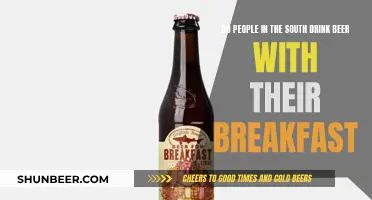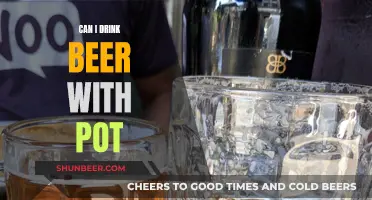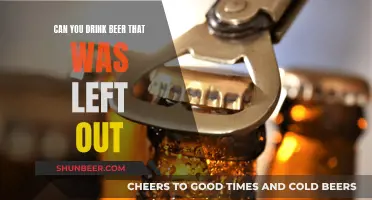
Nitro beers are beers infused with nitrogen gas, which subtly alters the aroma and flavour of the beer and gives it a silky, creamy mouthfeel. The process was popularised by Guinness, which remains the most well-known example of the style. Nitro beers are nitrogenated either before packaging in pressure-sealed kegs or in-line on the way to a draft system. They are served using a mixture of about 70% nitrogen and 30% carbon dioxide, colloquially called beer gas.
| Characteristics | Values |
|---|---|
| Gases used in carbonation | Nitrogen (N2) and Carbon Dioxide (CO2) |
| Typical nitrogenated beer composition | 70% nitrogen and 30% carbon dioxide |
| Mouthfeel | Creamier than CO2 beers |
| Texture | Smoother than CO2 beers |
| Bubbles | Smaller and more profuse than CO2 bubbles |
| Flavour | Subtly altered, with bitterness dulled |
| Malt flavours | Accentuated |
| Mouthfeel | Fuller |
| Appearance | Cascading effect of bubbles moving down and up |
| Head | Thick, dense, and full |
| Drink time | Should be drunk quickly, goes flat in <30 minutes |
What You'll Learn

The history of nitro beer
In the 1980s, Guinness revolutionised the industry once again by discovering a way to dispense nitrogen into beer bottles and cans under high pressure, making nitro beer more accessible to consumers. This was achieved through the use of a widget, a small nitrogen-filled ball that releases a surge of bubbles when the can or bottle is opened, replicating the draught experience. The widget was so popular that it won the Queen's Award for Technological Achievement in 1991.
While Guinness may have been the first to experiment with nitrogen in beer, other craft breweries have since embraced the trend and added nitro beers to their lineups. Left Hand Brewing Company, for example, introduced the first bottled nitro beer, Milk Stout Nitro, in 2011, without the use of a widget. This was followed by other craft breweries such as Sierra Nevada Brewing Co., Sixpoint Brewery, and Sly Fox Beer, who added nitro beers to their arsenals.
Today, nitro beer continues to be popular, with more craft breweries in the US and beyond experimenting with nitrogenation and offering nitro taps in their establishments. Nitro beer is known for its creamy texture, smooth flavour, and visually appealing cascading effect, making it a unique and enjoyable drinking experience.
Dissolved Oxygen in Beer: What's the Science?
You may want to see also

How nitro beer works
Nitro beers are beers that use nitrogen to create carbonation instead of carbon dioxide (CO2). They usually contain about 70% nitrogen and 30% carbon dioxide. Nitrogen is insoluble in liquid, so to get it to dissolve, it needs to be pressurized and kept cold. This process gives the beer a thick, creamy mouthfeel and a smooth texture.
Nitro beers are typically served on draft, with the nitrogenated liquid being forced through a restrictor plate, which has tiny holes, as it lands in the glass. This creates a rising" effect, with bubbles cascading down the sides of the glass and a thick, dense head of foam forming on top. The nitro beer then needs to be drunk quickly, as the nitrogen comes out of solution rapidly and the beer will go flat in less than 30 minutes.
The process of nitrogenating beer was popularized by Guinness, which was the only nitrogen-carbonated beer available for a long time. However, in recent years, more craft breweries have started to experiment with nitrogenating their beers, including stouts, porters, IPAs, and fruit beers.
Nitrogenating beer can also help extend the shelf life of the beer and manage dissolved oxygen. It provides a unique drinking experience with a smoother mouthfeel and a creamier texture compared to traditional carbonated beers.
Beer Slug Traps: Do They Work?
You may want to see also

The difference in taste
The difference between the two is particularly noticeable when comparing the same beer served using both methods. For example, the Left Hand Brewing Company offers a non-nitro and nitro version of its popular milk stout. When sampled side by side, the difference in texture and flavour distribution is vast. The nitro beer has a creamier texture and more evenly distributed flavours, while the CO2 beer is more aggressive on the tongue and more aroma-forward.
The nitro method is particularly well-suited to sweeter beers, such as porters and stouts, which is why most beers served on nitro tend to be malt-heavy rather than hop-forward. However, some brewers have also been experimenting with nitro in other styles, such as IPAs, wheats, reds, browns, cream ales, and even the occasional lager.
The unique qualities of nitro beers are not just down to the type of gas used but also the way the beer is poured. The nitro system, which is a mixture of 70% nitro and 30% CO2, creates a mesmerising cascade effect inside the glass, with a thick, foamy head. This is achieved through a special piece of tap equipment called a restrictor plate, which forces the beer through tiny holes before it lands in the glass.
Shotgunning Beer: How to Chug Instantly
You may want to see also

The process of carbonation
Nitrogenation of beer can be done before packaging in pressure-sealed kegs or in-line on the way to a draft system. Dedicated nitro drafts use the restrictor plate to force the beer through small holes, allowing the dissolved N2 gas to escape quickly and creating the cascading effect. This process gives the beer a creamy texture and a more evenly distributed flavour.
The carbonation process in traditional beers involves trapping carbon dioxide produced during fermentation or adding it during bottling or packaging. This results in a lively, prickly texture similar to soda or seltzer water.
Nitro beers are typically served on tap, with the nitrogen gas escaping from the beer as it is poured into a glass, creating a whirlpool effect with tiny bubbles. This effect is not only visually appealing but also contributes to the unique mouthfeel and flavour of nitro beers.
While nitro beers are known for their smooth and creamy texture, they are usually only mildly carbonated. The addition of nitrogen creates smaller and more profuse bubbles compared to carbon dioxide, resulting in a smoother and less aggressive mouthfeel.
Beer Trading: How Does It Work?
You may want to see also

The future of nitro beer
Nitro beer has been dubbed a fad at various points in history but has managed to stick around in modern drinking culture. The future of nitro beer looks promising, with more and more craft breweries embracing the nitrogenation method and adding such beers to their lineups.
The number of bars adding independent nitro taps is growing as more establishments embrace craft beer and break away from the traditions of larger breweries. Nitro beers are no longer limited to stouts and porters, with brewers experimenting with liquid nitrogen in IPAs, reds, browns, cream ales, and even lagers.
Liquid nitrogen can serve as a packaging solution for brewers making a variety of styles, and it has even been used to extend the shelf life of beer and manage dissolved oxygen. The flavour effects of liquid nitrogen dosing could also fit in with current trends such as milkshake IPAs, fruited sours, and dessert-forward stouts.
The increasing popularity of nitro beer can be attributed to several factors, including the growing number of nitro beer offerings in off-premise trade channels, the role of nitro beer in the on-premise arena, and the availability of non-alcoholic nitro beer options. Additionally, the variety of flavours offered by nitro beers, as well as their seasonal or special-release nature, contributes to their appeal.
Energy and Alcohol: Do Beer and Red Bull Work?
You may want to see also
Frequently asked questions
Nitro beer is beer that has been carbonated with nitrogen gas instead of carbon dioxide.
The nitrogen creates smaller bubbles and a smoother, creamier texture. The malt flavours are accentuated and the mouthfeel is fuller.
The nitrogen bubbles appear to move downwards into the beer, this is known as "cascading". The bubbles in the middle of the glass move upwards, creating a thick, full head.
You'll most commonly find dark beers like stouts and porters served as nitro beers, but some breweries are experimenting with putting lighter beers like IPAs and lagers on nitro too.
Nitro beers are mostly available on tap, but some breweries like Guinness, Left Hand Brewing, and Sam Adams have released canned or bottled nitro beers.







